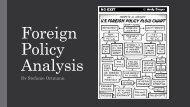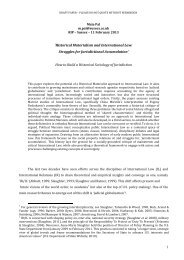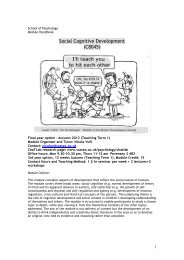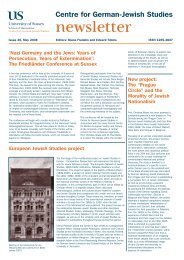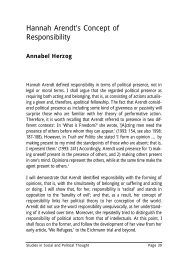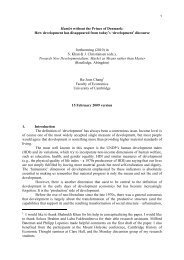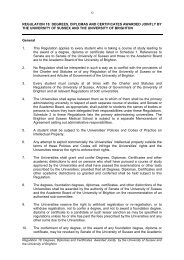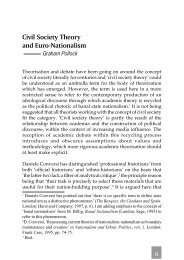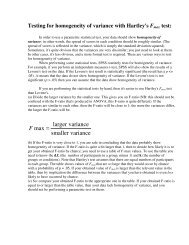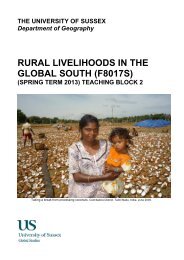Techniques for assessing shingle communities - University of Sussex
Techniques for assessing shingle communities - University of Sussex
Techniques for assessing shingle communities - University of Sussex
Create successful ePaper yourself
Turn your PDF publications into a flip-book with our unique Google optimized e-Paper software.
6. Pioneer <strong>communities</strong> 6a. Honckenya peploides dominated<br />
<strong>communities</strong><br />
6b. Senecio viscosus dominated<br />
<strong>communities</strong><br />
6c. Beta vulgaris dominated<br />
<strong>communities</strong><br />
6d. Raphanus maritimus 1 dominated<br />
<strong>communities</strong><br />
6e. Herb-dominated pioneer<br />
<strong>communities</strong><br />
6f. Silene maritima dominated pioneer<br />
<strong>communities</strong><br />
The above studies <strong>of</strong> Rodwell (2000) and Sneddon & Randall (1993) excluded Dungeness<br />
as it was subject to a three year mapping project aimed at providing a classification <strong>of</strong> the<br />
<strong>shingle</strong> <strong>communities</strong> <strong>of</strong> Dungeness based on the NVC scheme and a sufficiently detailed<br />
classification <strong>for</strong> use in field mapping <strong>of</strong> the vegetation (Ferry et al, 1990). The study<br />
revealed 18 distinguishable vegetation types, two <strong>of</strong> which could possibly have been further<br />
subdivided and several that are believed to be unique to the Dungeness <strong>shingle</strong> system.<br />
On a more local level, a preliminary assessment <strong>of</strong> vegetated <strong>shingle</strong> sites in East and West<br />
<strong>Sussex</strong> was carried out (Ryland, 1993) using aerial photographs to identify possible areas <strong>of</strong><br />
vegetated <strong>shingle</strong>. The list produced was further refined during field visits, and <strong>for</strong> those sites<br />
considered to be <strong>of</strong> greatest interest, a species list was produced and quadrat data was<br />
collected where appropriate (Williams & Cooke, 1993). The baseline <strong>for</strong> significant interest<br />
was the presence <strong>of</strong> a recognisable pioneer community, generally characterised by C.<br />
maritima and G. flavum. TWINSPAN analysis <strong>of</strong> the quadrat data identified six end groups<br />
(Fig. 2) which represented three basic types <strong>of</strong> community; pioneer, intermediate and<br />
established. The definitions <strong>of</strong> these three community types are as follows (Williams &<br />
Cooke, 1993; Ryland, 1999). Pioneer <strong>communities</strong> (Groups 1 and 4) are species poor and<br />
occur furthest down the beach where <strong>shingle</strong> is more prone to disturbance. C. maritima, R.<br />
crispus, B. vulgaris ssp. maritima, G. flavum and A. prostrata are characteristic. Intermediate<br />
communties (Groups 2 and 5) retain some <strong>of</strong> the pioneer species, but in addition support<br />
species such as Plantago lanceolata (Ribwort Plantain), Senecio jacobaea (Common<br />
Ragwort), Cerastium fontanum (Common Mouse-ear), Arenaria serpyllifolia (Thyme-leaved<br />
Sandwort) and Sonchus oleraceus (Smooth Sowthistle). Established <strong>communities</strong> (Groups 3<br />
and 6) have a closed turf, <strong>of</strong>ten bryophyte and lichen rich, characterised by a range <strong>of</strong><br />
species including Festuca rubra (Red Fescue), Pilosella <strong>of</strong>ficinarum (Mouse-ear-hawkweed,<br />
syn. Hieracium pilosella), Medicago lupulina (Black Medick) and S. uniflora.<br />
1 Raphanus maritimus syn. Raphanus raphanistrum ssp. maritimus<br />
<strong>Techniques</strong> <strong>for</strong> <strong>assessing</strong> <strong>shingle</strong> <strong>communities</strong> 6




